Research highlights 2016
Permanent excimer superstructures by supramolecular networking of metal quantum clusters
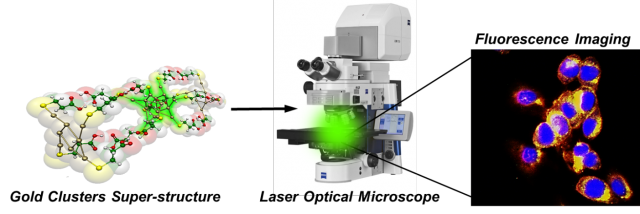
Metal quantum clusters have ideal properties for medical applications such as imaging. The challenge is to prolong their transient properties for the fabrication of useful devices. We arranged gold clusters in a supramolecular lattice held together by hydrogen bonding and showed that this material can be used for imaging of fibroblast cells. In the superstructure, the gold molecules can come together in the excited state as excimers and then dissociate to emit radiation. Because they are within a lattice, this behavior shows long-term stability. Furthermore, the lattice superstructure scavenges reactive oxygen species and reduces cell damage.
B. Santiago-Gonzalez, A. Monguzzi, J. M. Azpiroz, M. Prato, S. Erratico, M. Campione, R. Lorenzi, J. Pedrini, C. Santambrogio, Y. Torrente, F. De Angelis, F. Meinardi, S. Brovelli, Permanent excimer superstructures by supramolecular networking of metal quantum clusters, Science 353, 571-575 (2016)
Highly Mismatched, Dislocation-Free SiGe/Si Heterostructures
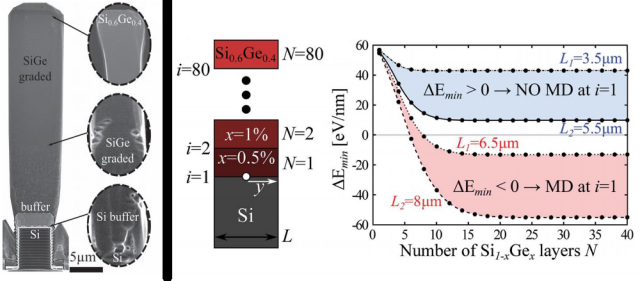
Above a certain critical thickness, dislocations are unavoidably introduced in lattice-mismatched heteroepitaxial films. As such defects can be detrimental in affecting devices’ performances, lowering their density is a key issue in present optics and microelectronics. Thanks to their huge height to base aspect ratio, small (width below 50 nm) nanowires can be grown dislocation-free, as the abundance of free surfaces allows for a massive elastic relaxation of the misfit-strain. In this work it is shown that total absence of dislocations can be achieved also at the micron scale, provided that (a) vertical heteroepitaxy can be achieved (b) the content of the stressor is slowly increased during deposition.
In the figure – Left: SiGe dislocation-free, micrometer-sized vertical crystal grown by Low-Energy Plasma Enhanced Chemical Vapour Deposition. Right: theoretical calculations predicting the absence of dislocations for widths up to ~5μm.
Isa, F; Salvalaglio, M; Dasilva, Y; Meduňa, M; Barget, M; Jung, A; Kreiliger, T; Isella, G; Erni, R; Pezzoli, F; Bonera, E; Niedermann, P; Gröning, P; Montalenti, F; von Känel, H. Highly Mismatched, Dislocation-Free SiGe/Si Heterostructures, Adv. Mater. 28, 884 (2016).
Bismuth-Based Coordination Polymers with Efficient Aggregation-Induced Phosphorescence and Reversible Mechanochromic Luminescence

Coordination polymers (CPs) are very promising luminogens for lighting technologies and chemical sensors, but their emission efficiency usually decreases dramatically upon aggregation as a result of concentration quenching processes. Here we report the first bismuth-based CPs showing not only a solid-state phosphorescence quantum yield as high as 85%, due to an aggregation induced phosphorescence process, but also mechanochromic luminescence (MCL). In particular, upon grinding the samples, their amorphisation induce a shift of the emission from the yellow to the orange-red while the color of the powders remained unchanged. The total wavelength shift (more than 100 nm) is the largest ever observed for MCL complexes and it is fully reversible upon heating. Starting from this results, a new family of MCL materials is actually under development.
In the figure: UV-excited luminescence of one of the synthesized CPs upon grinding for different times.
Toma, O; Allain, M; Meinardi, F; Forni, A; Botta, C; Mercier, N., Bismuth-Based Coordination Polymers with Efficient Aggregation-Induced Phosphorescence and Reversible Mechanochromic Luminescence, Angew. Chem. Int. Ed. 55, 7998. (2016).
Size-dependent penetratin of gold nanoclusters through a defect-free, nonporous NaCl membrane
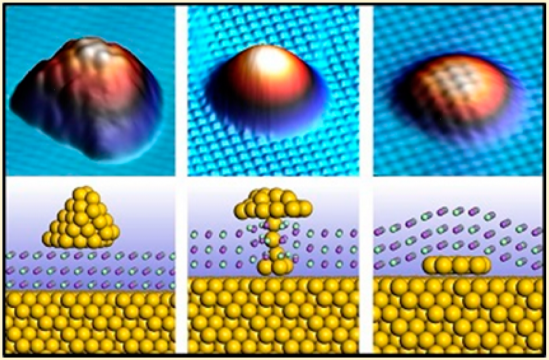
Metal quantum clusters have ideal properties for medical applications such as imaging. The challenge is to prolong their transient properties for the fabrication of useful devices. We arranged gold clusters in a supramolecular lattice held together by hydrogen bonding and showed that this material can be used for imaging of fibroblast cells. In the superstructure, the gold molecules can come together in the excited state as excimers and then dissociate to emit radiation. Because they are within a lattice, this behavior shows long-term stability. Furthermore, the lattice superstructure scavenges reactive oxygen species and reduces cell damage.
Z. Li, H.Y. T. Chen, K. Schouteden, T. Picot, K. Houben, T.W. Liao, C. van Haesendonck, G. Pacchioni, P. Lievens, E. Janssens, Size-dependent penetratin of gold nanoclusters through a defect-free, nonporous NaCl membrane, Nano Lett. 16, 3063 (2016).
Pseudodirect to Direct Compositional Crossover in Wurtzite GaP/InxGa1-xP Core-Shell Nanowires
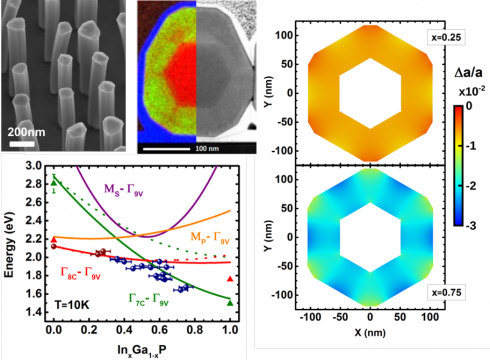
Thanks to their geometry, core-shell nanowires allow the realization of novel semiconductor crystal structures with yet unexplored properties, such as to induce in the shell a crystal structure different from the bulk one. In fact, we obtained the growth of wurtzite GaP/InxGa1−xP core−shell nanowires, with tunable indium concentration x, suitable for optical emission in the visible region, from 590 nm to 760 nm. We demonstrate a crossover from pseudodirect (Γ8c−Γ9v) to direct (Γ7c−Γ9v) transition with x, both experimentally and by Density Functional Theory calculations. As the increasing strain in the shell with x too does affect the electronic band structure, Finite Element Method calculation of the strain in the system has been performed. This work opens the way applications in solid state lighting, tandem solar cells, and solar hydrogen production.
Gagliano, L; Belabbes, A; Albani, M; Assali, S; Verheijen, M; Miglio, L; Bechstedt, F; Haverkort, J; Bakkers, E., Pseudodirect to Direct Compositional Crossover in Wurtzite GaP/InxGa1-xP Core-Shell Nanowires, Nano Lett. 16, 7930 (2016).
Enhanced Reactivity at the Interface between (Doped) Graphene and Anatase TiO2
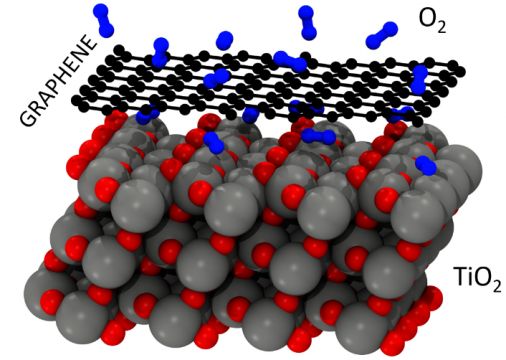
The “catalysis under cover” involves chemical processes which take place in the confined zone between a 2D material, such as graphene, and the surface of an underlying support, such as a metal oxide. The hybrid interface between graphene and anatase TiO2 is extremely important for photocatalytic and catalytic applications.
We investigate and discuss the reactivity of O2 and H2O on top and at the interface of this system by means of dispersion-corrected hybrid density functional calculations. Pure and boron- or nitrogen-doped graphene are interfaced with the most stable (101) anatase surface of TiO2 in order to improve the chemical activity of the C-layer. Especially in the case of boron, an enhanced reactivity toward O2 dissociation is observed as a result of both the contribution of the dopant and of the confinement effect in the bidimensional area between the two surfaces. Stable dissociation products are observed where the boron atom bridges the two systems by forming B-O covalent bonds. On the contrary, the same conditions are not found to favor water dissociation, proving that the “catalysis under cover” is not a general effect, but rather highly depends on the interfacing material properties, on the presence of defects and impurities and on the specific reaction involved.
Ferrighi, L; Datteo, M; Fazio, G; Di Valentin, C., Catalysis under Cover: Enhanced Reactivity at the Interface between (Doped) Graphene and Anatase TiO2, J. Am. Chem. Soc. 138, 7365 (2016).
Recognition of 1,3-Butadiene by a Porous Coordination Polymer
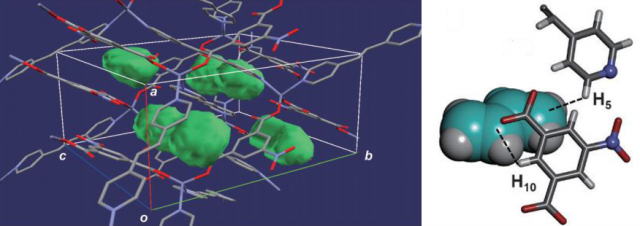
Metal Organic Frameworks (MOFs) retail in their porous structure such a specific room for butadiene, a precursor of synthetic elastomers, that this molecule can be separated from similar hydrocarbon mixtures with unprecedented efficiency.
The new purification process contributes to the relevant issue of using functional absorptive materials for important industrial applications. The host-guest steric interaction could be recognized by magic angle spinning NMR, which highlighted host-guest close proximity in the crystal.
From the viewpoint of materials design for specific gas separation under ambient conditions, the results of this study suggest that the key is to combine both narrow voids and structural flexibility for the separation of light gas mixtures.
Kishida, K; Okumura, Y; Watanabe, Y; Mukoyoshi, M; Bracco, S; Comotti, A; Sozzani, P; Horike, S; Kitagawa, S., Recognition of 1,3-Butadiene by a Porous Coordination Polymer, Angew. Chem. Int. Ed. 55, 13784 (2016).
Effect of Core/Shell Interface on Carrier Dynamics and Optical Gain Properties of Dual-Color Emitting CdSe/CdS Nanocrystals
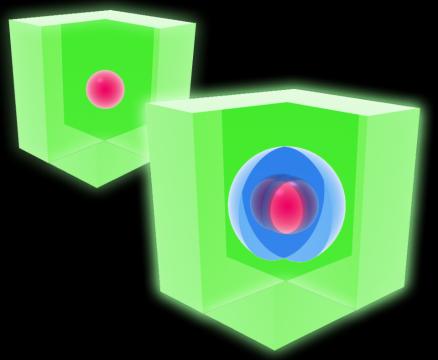
Two-color emitting colloidal semiconductor nanocrystals (NCs) are of interest for applications in multimodal imaging, sensing, lighting, and integrated photonics. In this study, we elucidate the effect of the interface morphology on the dual emission property of a special class of CdSe/CdS NCs consisting of a small core and a bulk-like shell.
Side-by-side comparison between NCs with identical dimensions but different core/shell interface reveal that systems with a zincblende core show a faster growth of shell luminescence with excitation fluence and a more readily realized regime of amplified spontaneous emission (ASE) even under “slow” nanosecond excitation. These distinctions are ascribed to the creation of a potential barrier (blue in figure) for photoexcited shell holes inhibiting their relaxation into the core that helps maintain a higher population of shell states and simplifies the realization of dual emission and ASE involving shell-based optical transitions.
Pinchetti, V; Meinardi, F; Camellini, A; Sirigu, G; Christodoulou, S; Bae, W; De Donato, F; Manna, L; Zavelani-Rossi, M; Moreels, I; Klimov, V; Brovelli, S., Effect of Core/Shell Interface on Carrier Dynamics and Optical Gain Properties of Dual-Color Emitting CdSe/CdS Nanocrystals, ACS Nano 10, 6877 (2016).
Electrolytes for Lithium Batteries: Mechanisms and Properties Governing Ion Conduction
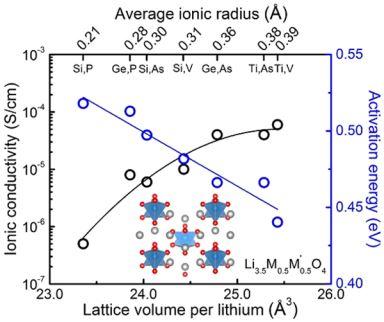
Bachman, J; Muy, S; Grimaud, A; Chang, H; Pour, N; Lux, S; Paschos, O; Maglia, F; Lupart, S; Lamp, P; Giordano, L; Shao-Horn, Y. Inorganic Solid-State Electrolytes for Lithium Batteries: Mechanisms and Properties Governing Ion Conduction, Chem. Rev. 116, 140 (2016)
Spectroscopic and Device Aspects of Nanocrystal Quantum Dots
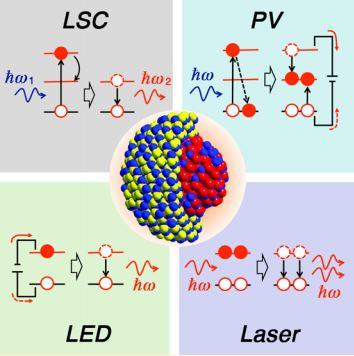
Pietryga, J; Park, Y; Lim, J; Fidler, A; Bae, W; Brovelli, S; Klimov, V., Spectroscopic and Device Aspects of Nanocrystal Quantum Dots, Chem. Rev. 116, 10513 (2016)
Molecular Rotors Built in Porous Materials
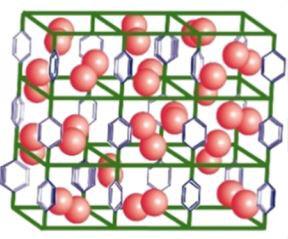
Comotti, A; Bracco, S; Sozzani, P., Molecular Rotors Built in Porous Materials, Acc. Chem. Res. 49, 1701 (2016)